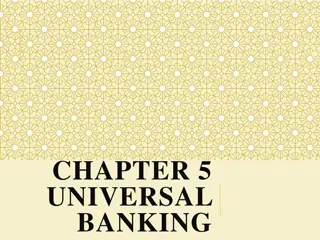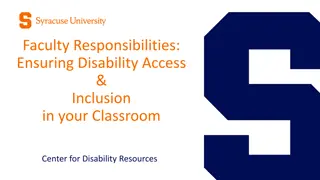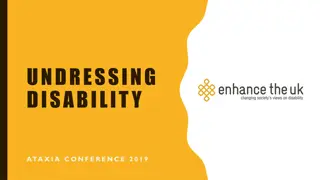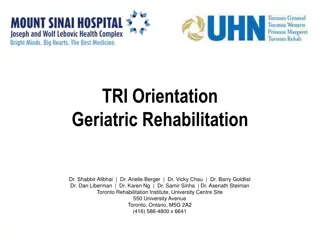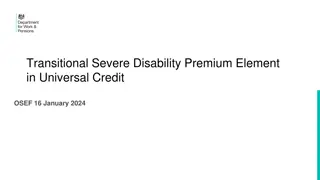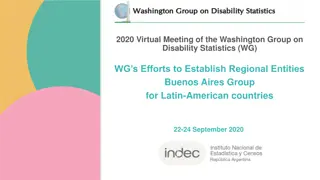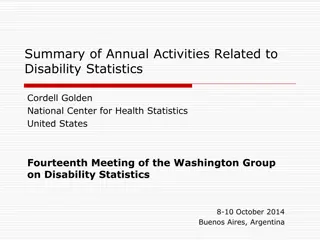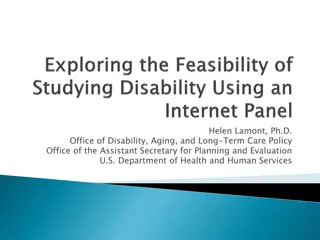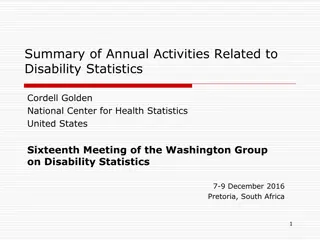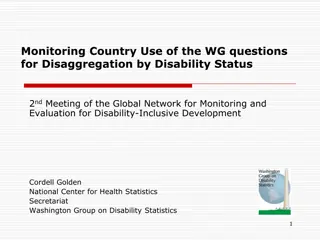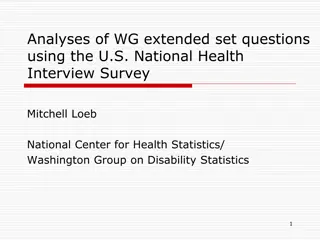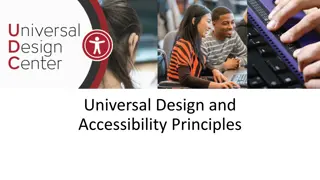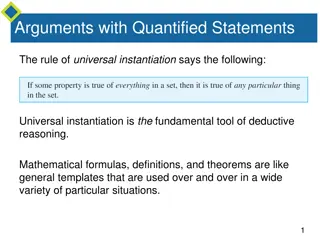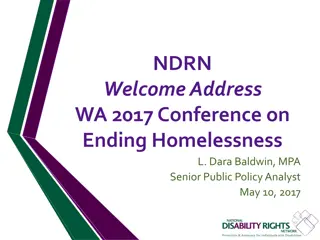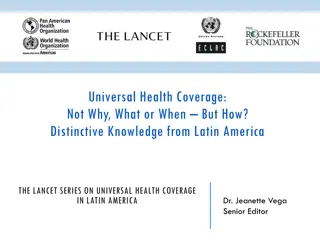Exploring Universal Design in National Service and Disability Community
The presentation delves into Universal Design (UD) and its application in National Service and the disability community. It discusses ways to enhance program design beyond physical aspects, focusing on Universal Design for Learning and architecture. The content showcases how individuals use UD to create inclusive environments, with insights from the Association of University Centers on Disabilities. It also highlights key standards such as those by ANSI and the Americans with Disabilities Act. The workshop aims to inspire innovative approaches to include diverse learners and promote accessibility in various settings.
Download Presentation

Please find below an Image/Link to download the presentation.
The content on the website is provided AS IS for your information and personal use only. It may not be sold, licensed, or shared on other websites without obtaining consent from the author. Download presentation by click this link. If you encounter any issues during the download, it is possible that the publisher has removed the file from their server.
E N D
Presentation Transcript
The Future. in Universal Design Presenters: Sue Lin, Project Director Karla Kmetz, Project Specialist Association University Centers on Disabilities (AUCD)
Who we are What is Universal Design (UD)? How can UD be applied to National Service and within the disability community? A look at how people currently use UD Young Adult Transition Corps (YATC) Activity: How do you move this beyond the physical to enhanced program design?
67 University Centers of Excellence on Developmental Disabilities (UCEDD) 38 Leadership Education in Neurodevelopmental and Related Disabilities (LEND) 21 Developmental Disabilities Research Centers (DDRC) Research & Evaluation Inter- Community Services disciplinary Training Technical Assistance and Information Dissemination
Introduce yourself! Name Organization Location Hobbies/Interests/Something interesting about you How you are involved in National Service Explain how the object you picked describes you What you hope to take away from this workshop
Universal Design in Architecture and Physical Environments design of structures that anticipates the needs of individuals with disabilities and accommodates these needs from the outset
American National Standards Institute (ANSI) 1961: Specifications for Making Buildings and Facilities Accessible to and Usable by people with physical disabilities Uniform Federal Accessibility Standard (UFAS) Adapted ANSI standard for federally funded construction Fair Housing Amendment 1988: Access guidelines to multiple housing units Americans with Disabilities Act 1990: Mandatory conditions for public spaces
Universal Design for Learning design curricula with the needs of all learners in mind, so that, methods, materials and assessments are usable by all.
Assistive technology device is defined as any item, piece of equipment, or product system, whether acquired commercially off-the-shelf, modified or customized, that is used to increase, maintain, or improve functional capabilities of individuals with disabilities. Assistive Technology Act of 1998 Assistive Technology Act of 1998
1. Equitable Use 2. Flexibility in Use 3. Simple and Intuitive Use 4. Perceptible Information Equitable Use Flexibility in Use 3. Simple and Intuitive Use 4. Perceptible Information 1. 2.
5. Tolerance for Error 6. Low Physical Effort 7. Size and Space for Approach and Use Tolerance for Error 6. Low Physical Effort 7. Size and Space for Approach and Use
The design is useful and marketable to people with diverse abilities Provide the same means of use for all users: identical whenever possible; equivalent when not. Avoid segregating or stigmatizing any users. Provisions for privacy, security, and safety should be equally available to all users. Make the design appealing to all users.
The design accommodates a wide range of individual preference and abilities. Provide choice in methods of use. Accommodate right- or left-handed access and use. Facilitate the user's accuracy and precision. Provide adaptability to the user's pace.
Use of the design is easy to understand, regardless of the user's experience, knowledge, language skills, or current concentration level. Eliminate unnecessary complexity. Be consistent with user expectations and intuition. Accommodate a wide range of literacy and language skills. Arrange information consistent with its importance. Provide effective prompting and feedback during and after task completion.
The design communicates necessary information effectively to the user, regardless of ambient conditions or the user's sensory abilities. Use different modes (pictorial, verbal, tactile) for redundant presentation of essential information. Provide adequate contrast between essential information and its surroundings. Maximize "legibility" of essential information. Differentiate elements in ways that can be described (i.e., make it easy to give instructions or directions). Provide compatibility with a variety of techniques or devices used by people with sensory limitations.
The design minimizes hazards and the adverse consequences of accidental or unintended actions. Arrange elements to minimize hazards and errors: most used elements, most accessible; hazardous elements eliminated, isolated, or shielded. Provide warnings of hazards and errors. Provide fail safe features. Discourage unconscious action in tasks that require vigilance.
The design can be used efficiently and comfortably and with a minimum of fatigue. Allow user to maintain a neutral body position. Use reasonable operating forces. Minimize repetitive actions. Minimize sustained physical effort
Appropriate size and space is provided for approach, reach, manipulation, and use regardless of user's body size, posture, or mobility. Provide a clear line of sight to important elements for any seated or standing user. Make reach to all components comfortable for any seated or standing user. Accommodate variations in hand and grip size. Provide adequate space for the use of assistive devices or personal assistance.
Universal Design for Learning Principles
Principle 1: To support recognition learning, and provide multiple, flexible methods of presentation Principle 2: To support strategic learning, and provide multiple, flexible methods of expression Principle 3: To support affective learning, and provide multiple, flexible options for engagement
Accommodate individual learning differences Multiple means of representation to give learners various ways of acquiring information and knowledge, Multiple means of expression to provide learners alternatives for demonstrating what they know, and Multiple means of engagement to tap into learners' interests, challenge them appropriately, and motivate them to learn
Individuals with Disabilities Education Act (IDEA) reauthorized in 2004 and No Child Left Behind of 2001 IDEA and NCLB - Require accountability of schools in providing equal access to curriculum by all students and all types of learners IDEA - Guarantees a free and appropriate public education to every child identified as needing special education in least restrictive environments Individuals with Disabilities Education Act (IDEA) reauthorized in 2004 and No Child Left Behind of 2001
Higher Education Opportunity Act 2008 Incorporates Universal design for learning Creates statutory definition: UNIVERSAL DESIGN FOR LEARNING.. The term universal design for learning means a scientifically valid framework for guiding educational practice that (A) provides flexibility in the ways information is presented, in the ways students respond or demonstrate knowledge and skills, and in the ways students are engaged; and (B) reduces barriers in instruction,, provides appropriate accommodations, supports, and challenges, and maintains high achievement expectations for all student including students with disabilities and students who are limited English proficient. Includes UDL in several provisions related to teacher training Development of postsecondary teaching strategies and methods, and curriculum development consistent with UDL
Provide multiple examples Highlight critical features Provide multiple media and formats Support background context
Provide flexible models of skilled performance Provide opportunities to practice with supports Provide ongoing, relevant feedback Offer flexible opportunities for demonstrating skill
Offer choices of content and tools Offer adjustable levels of challenge Offer choices of rewards Offer choices of learning context
Are you using components of UD in your programs? Example of physical/structural UD Example of programmatic UD
Young Adult Transition Corps is committed to improving the quality of life for youth with disabilities who are transitioning from school to adult life through activities that promote community service, community access, and social skill development.
10 members, 5 with disabilities & 5 without Including: Learning Disabilities Physical Disabilities Sensory Disabilities Backgrounds: Social Work Occupational Therapy English Psychology Art Education Special Education Speech and Hearing Science
Design of YATC Office Meeting materials Available in print, electronically, and projected during meeting Working in teams Flexible hours Choice of service activities
Preparation Choose a project, planning Action The project (including any small projects that need to be done before the main project) Reflection Connect the project with learning objectives Students connect to the contribution they have made Celebration Recognize everyone s contribution Party!!
The project: Garden Party at local Senior Center Skills gained: Letter writing Presentation Time and Money Management Teamwork and Social Decision Making
Preparation Identifying a need and choosing a project Garden Party for Senior Residence Home Breaking the project into tasks and creating a timeline Preparing a list of supplies needed and a budget
Action Preparing materials for and practicing activities for the event (bird feeder, garden collage, and songs) Writing and delivering donation letters The Garden Party
Reflection Guided reflection worksheets/journal Class discussion
Celebration Corps members recognized contributions of each student Party!
Transportation Transition Staff and corps members leaving the program need to pass on knowledge and skills Resource Mapping Service systems Education system Service Members Volunteer Burnout Tensions within the Corps
Applying Universal Design from learning to practice
Five Groups 1. School administrators, teachers, and other related staff 2. Individuals with physical disabilities 3. Individuals with sensory disabilities (vision and hearing) 4. Individuals with learning disabilities 5. Community Partnership Organizations receiving service
School would like to foster a UD service learning environment. In order to design and effectively implement the program, it requires the collaborative efforts by school staff, members of the disability community and community partner organizations. Process: Through a series of group discussion questions, participants will practice ways to analyze universal design issues, build consensus, and create goals and objectives.
Implement recycling program Working with city environmental agency Develop public awareness and communication outreach materials Host service days for students in local middle school



